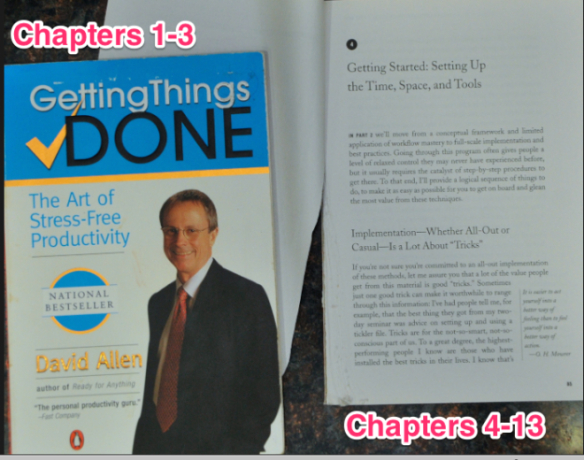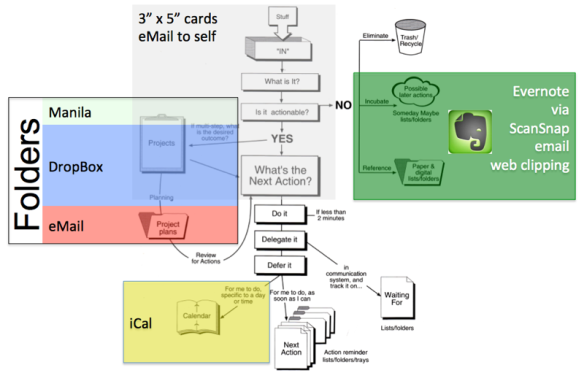TLDR:
You can do both GTD and Evernote if:
- You read only chapters 1-3 of GTD, then
- implement Evernote as your reference filing system,
- don’t forget to install three Evernote add ons,
- be well rested when you work (don’t sleep walk) and
- focus on doing one new GTD skill (reference filing) well, before adding others.
If you don’t do all these steps, you … will … fail and then likely stop using both GTD and Evernote. Failing does not have to happen.
/TLDR:
Reason #1: Too Many Changes At Once
The only reason for time is so everything doesn't happen at once. - Albert Einstein
OK, you’ve picked up GETTING THINGS DONE (GTD) and you read the first three chapters. You stopped, considered my explicit instructions (see step 4) not to read the rest of the book for a year. In fact, when I give away GTD (I’ve given away over 50 copies so far) I physically cut the binding at chapter 4, and then do not give the last part of the book … until a year later. 
But most people do not buy defaced copies of GTD, or cut their books. So, they get excited in the first three chapters, and with boundless (temporary) energy, read the rest of the book. Embarking on a mission to change years of organizing habits, in three days. Prepare thine head … to be pulled off.
Even unemployed people can’t implement GTD in three days, a week, or even a month. I’ve seen them try. Changing everything at once is too much “shaking the jello.”
For example:
- Gathering work into a reduced number of inboxes
=new jello … shaking. - pre-processing inboxes without doing the work simultaneously
=new jello … shaking. - Setting up separate project and reference folders
=new jello … shaking. - And in the middle of all this shaking GTD jello, you are becoming tired, overwhelmed while excited, so you are basically sleep walking, while continuing to read and continuing to decide to shake more jello because David Allen has given you hope.
- Hope is something you have not had about organizing your work in say, 3 years. Hope at this point, inebriates.
- So, you set up an Evernote account, downloaded Evernote, install Evernote, check that Evernote works. Evernote is (sleep walking) working!
But, implementing GTD is such an overwhelming experience, after you get Evernote installed and running, you sleep-walk back to read GTD chapters 4-13. More jello!!!
Then you take a break. Spontaneously your hope from reading GTD, begins to dissolve in guilt. Wait, what?
Trouble with the GTD editor.
Captain Awkward calls it JerkBrain. I think of it as my internal editor. In THE WAR OF ART, Steven Pressfield calls it resistance, whatever you call it. As soon as you learn some of the tools of GTD, something inside your head will begin to fight against you implementing any of the tools of GTD. An this internal counter-GTD force, will begin piling up guilt in your mind.
A growing sense of guilt, combines with growing exhaustion from trying to reorganize all organizing tools … at once. And it is inevitable. You are going to have to stop implementing GTD and rest. And once you rest, JerkBrain, internal GTD editor, RESISTANCE, whatever you call it, sees its job, as keeping you from going back to GTD, and doing more implementing. One force in your head wants to implement, the other wants you off GTD the wagon.
And in this subconscious battle zone, enters the thought of installing Evernote. Or, … OneNote, … OmniFocus, … Dropbox, … Google Drive, … Google Apps, … maybe even buying a ChromeBook, … whatever. On the left hand side of your head, you have a list of many new GTD tools to implement: inbox, project list, project folders, 2-minute-rule. And on the right hand side, you have a list of many applications programs and systems to implement.
The key to actually implementing GTD is concentration. Concentrate efforts on fully implementing one GTD aspect, an aspect that will get you a big enough payoff, to shut down JerkBrain/GTD editor/RESISTANCE. For me, the one big thing was reference filing.
But, when you are tired, overwhelmed, and barely back to GTD after a night of sleep, or a weekend of family, or the latest big-baby-drama in your life, the automatic thought about reference filing is:
“Reference filing, no big deal.”
This.
Is.
Wrong.
Reference filing, the green box in this image, is a keystone skill of GTD.
Not a mote, reference filing is a board in your eye. A board because if you are going to make the switch to GTD, Step 1 is to get (currently) useless paper out of your face. Going to paperless reference filing with GTD is a HUGE payoff. You will be able to find information in 15 seconds, that you currently are too discouraged to even try to look for.
And once you can find all the paper that your brain knows you should be able to find. JerkBrain/GTD edtior/RESISTANCE will be shut up long enough, to let you get some work done. And, the work will go faster than you are used to, because you can actually bring together ALL the key information you know you should be able to find, and get quick wins.
Did I mention that reference filing is not trivial? Hope I remembered that!
Reference filing setup requires:
- sustained attention,
- effort-while-being-well-rested, and
- equipment that costs real money.
Reference filing is a HUGE challenge. But if you can implement Evernote for reference filing and suddenly have all your key information available, you will:
- Clear your desk of paper (“So there JerkBrain!”)
- Clear your office of file cabinets (“Hah GTD editor!”)
- Allow you to find anything in your old paper files in 15 seconds (this is HUGE it allows your subconscious to trust your change to a new system where subconscious does not need to “not-forget” all your important historical materials).
- Give you a quick win to overcome cynicism in yourself, and in your peers (it is much better to hear “Why are you so happy?” after a week from your spouse, than “You were all diarrhea mouth about GTD, but nothing has changed. What is up with that?”).
- And set you up to be successful implementing later pieces of shaking GTD jello.
*Note* having an Evernote account, having Evernote installed, and having Evernote running, is not having an Evernote reference filing system.
Installing Evernote while sleep-walking makes you miss three key components of Evernote’s dominant design.
- Evernote Web Clipper.
- Evernote Clearly. And
- Evernote Skitch.
Without all three of these tools your GTD system will leak all your internet information. As the internet is now the largest source of reference materials, this omission is sin. One byte of data about this …
A Clearly Example:
Last weekend I helped a friend who had bought Evernote Pro based on an enthusiastic Evernote demonstration two years ago. But after installing, she did not use Evernote. When I reviewed her Evernote installation, Web Clipper, Clearly, and Skitch, were not installed. So, we installed them (2 minutes) and then I pointed her to PC Magazine (single most cluttered web site on the internet) and demonstrated Web Clipper and Clearly. When she saw that in one click:
- she could strip all clutter and advertising from web pages, and
- she could highlight passages in web pages, and
- that the web pages automatically save into Evernote, and
- that Evernote automatically put documents in folders where they are wanted,
she said:
“Clearly all by itself makes using Evernote worth it.”
Read that sentence again!
Summary:
I’ve heard that of all the people that attend the $800 GTD seminars, only about 17% actually successfully implement GTD. If there is an 83% failure rate implementing GTD, and in the middle of that failure there is this “Reference filing, no big deal!” trap where you run into:
- a ton of short term setup,
- need-for-un-wavering-attention,
- budgeting time to work while being well-rested, and
- significant costs,
There is no way you can reach Evernote critical mass. Heck, 83% of people don’t reach GTD critical mass! Changing one organizing habit at a time, is a TON of work. 83% of people succumb to JerkBrain/GTD editor/RESISTANCE.
So, if you want to implement GTD, plan on doing so part time. Budget mental resources in advance to confront JerkBrain/GTD editor/RESISTANCE. But most importantly plan to be patient. Plan to slow down.
And, did I mention, plan to slow down. Organization is a skill like personal training. You got fat over a long period of time. You will not get lean in 3 days. Your physical trainer will manage your expectations for you. But with GTD, you don’t have a personal trainer. You have to manage your own expectations.
Pick the one GTD tool that will give you the highest payoff, implement one tool well, and then move to the next tool.
GTD’s tool payoff precedence for me has been:
- Reference filing
- Getting a real desk (see Restart GTD’s best-selling-post: Perfect GTD Desk)
- Natural project management
Good luck! If you have questions, post them below this post. So far, this is the most read post on RestartGTD. Everyone has questions about reference filing and GTD. Everyone who starts implementing Evernote will run into a roadblock. Roadblocks are the keys to the masterpiece.
-bill
And these three tools take at least a year to master. After you implement these three, I deputize you to read chapters 4-13 in GTD. But, … not until then.
bill meade


